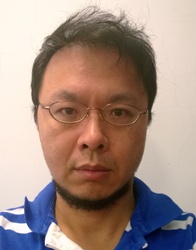周俊廷 Chun-Ting Chou
主要研究領域:
無線網路通訊協定,超高速個人無線區域網路,認知型智慧無線網路Major Research Areas:
wireless network protocol design, ultra wide band (UWB) wireless personal area network, cognitive radio networks, medium access control研究領域摘要:
1. 認知型無線網路:新一代無線裝置具有根據資源使用的情形及法規允許之下動態的使用無線頻譜限制的頻譜。為了充分利用此種能力,互相連接中的無線裝置之間必須尋找暫時無人使用的頻帶,且需在避免干擾到使用已註冊頻譜的無線裝置之前提下,互相協調裝置間對頻譜的使用。本研究計畫將重點放在設計跨MAC層及PHY層之頻譜偵測機制以及設計一新型的MAC通訊協定,以之發展可實際運作之認知型無線通訊網路。經由理論分析以及電腦模擬,將可驗證此通訊協定,並展示研究成果於現有的無線裝置中。
2. 數倍Gigabytes級無線傳輸:新興的網路應用例如:高解析度HD串流影片、高速檔案傳輸,需要至少每秒數個gigabytes等級的傳輸速度。超寬頻(Ultra-wide-band)以及毫米波傳輸(millimeter-wave)技術雖然可以提供如此極端的實體層傳輸速率,但仍受限於資料吞吐效率不佳以及傳輸距離不足的問題。為解決前述的議題,本研究計畫將研究使用指向性網路通訊協定(directional network protocols)等各種技術,並透過與GICE毫米波無線傳輸的整合,提供數倍gigabyte等級的傳輸速度之完整系統解決方案。
3. 合作式傳輸:合作式傳輸需要稱為「轉傳點」的額外裝置,來參予來源端以及接收端之間之傳輸。目前已證實經由適當的編碼以及綜合來源端與轉傳點的傳輸,接收端可以在不使用複數天線的情況之下,提高空間分集增益,此技術對於受限於裝置大小以及電池容量的低成本無線裝置是相當有用的。本研究根據MAC層的角度著眼於上述議題,發展低負荷之交握機制以及轉傳點選擇問題,以期參與傳輸的轉傳點能在自治的模式之下發揮合作式傳輸的能力。
4. 可變規模感測器網路:感測器已在製造業自動化、建築業經營管理以及醫療應用上﹙如:病情監控﹚被廣為利用。這些數以千計的感測器可形成一個相當巨大的網路,但此種網路終究會遭遇可靠度及規模大小改變上的議題。本研究計畫將研究上述議題,並發展一可變規模無線感測器網路以適應各種多變的應用。
Research Summary:
1.Cognitive wireless networks: Next generation radios are capable of utilizing unused spectrum opportunistically, subject to regulatory restriction. To fully exploit such capability, communicating ratios must discover unused spectrum and coordinate their use of spectrum without interfering the licensed radios. This research will focus on the design of cross MAC- and PHY-layer spectrum-sensing mechanisms and new MAC protocols to enable cognitive wireless communication. The protocol will be validated via theoretical analysis and simulation, and will be implemented using off-the-shelf radios to demonstrate the performance.
2.Multi Gigabytes wireless transmission: Emerging applications such as high definition (HD) video streaming and fast file transfer require at least multi-gigabyte bits-per-second wireless links. Ultra-wide-band (UWB) and millimeter-wave technologies can provide such extremely-high PHY-layer rates but suffer from throughput inefficiency or short transmission range. This research will investigate various techniques, such as directional network protocols, to address these issues. Such techniques could be integrated with GICE’s millimeter-wave RFs to provide full-system multi-gigabyte solutions
3.Cooperative transmission: Cooperative transmission requires a third device, called a relay, to participate in the transmission between the source and destination. It has been shown that by properly encoding and combing transmissions from the source and the relay, the destination device can obtain a spatial diversity gain without using multiple antennas. This is very useful for low-cost wireless devices as in general they are limited in size and battery capacity. This research addresses the issues from the MAC layer’s perspectives. Light-weight handshaking mechanisms and relay selection will be developed so that the cooperative transmission is “activated” by participants in an autonomous manner.
4.Scalable sensor networks: Sensors are widely used in manufacturing automation, building management or medical applications such as patient monitoring. These sensors may form a huge network with thousands of nodes, which eventually will suffer from reliability or scalability issue. This research will investigate these issues and develop a scalable wireless sensor network for various applications.

-
B.S.
National Taiwan University, 1995 -
M.S.
National Taiwan University, 1997 -
Ph.D.
University of Michigan, Ann Arbor, 2004
-
Address
MD-618,
Department of Electrical Engineering,
National Taiwan University,
Taipei 106, Taiwan -
Phone
+886-2-33663537 -
FAX
: +886-2-33663537 -
Email:

-
Office Hour
: Tue. 14:00~15:00, Thu. 14:00 ~15:00 -
Personal Homepage
http://nxg.ee.ntu.edu.tw/web/index